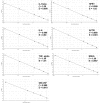Relative quantification of mRNA: comparison of methods currently used for real-time PCR data analysis
- PMID: 18093344
- PMCID: PMC2235892
- DOI: 10.1186/1471-2199-8-113
Relative quantification of mRNA: comparison of methods currently used for real-time PCR data analysis
Abstract
Background: Fluorescent data obtained from real-time PCR must be processed by some method of data analysis to obtain the relative quantity of target mRNA. The method chosen for data analysis can strongly influence results of the quantification.
Results: To compare the performance of six techniques which are currently used for analysing fluorescent data in real-time PCR relative quantification, we quantified four cytokine transcripts (IL-1beta, IL-6 TNF-alpha, and GM-CSF) in an in vivo model of colonic inflammation. Accuracy of the methods was tested by quantification on samples with known relative amounts of target mRNAs. Reproducibility of the methods was estimated by the determination of the intra-assay and inter-assay variability. Cytokine expression normalized to the expression of three reference genes (ACTB, HPRT, SDHA) was then determined using the six methods for data analysis. The best results were obtained with the relative standard curve method, comparative Ct method and with DART-PCR, LinRegPCR and Liu & Saint exponential methods when average amplification efficiency was used. The use of individual amplification efficiencies in DART-PCR, LinRegPCR and Liu & Saint exponential methods significantly impaired the results. The sigmoid curve-fitting (SCF) method produced medium performance; the results indicate that the use of appropriate type of fluorescence data and in some instances manual selection of the number of amplification cycles included in the analysis is necessary when the SCF method is applied. We also compared amplification efficiencies (E) and found that although the E values determined by different methods of analysis were not identical, all the methods were capable to identify two genes whose E values significantly differed from other genes.
Conclusion: Our results show that all the tested methods can provide quantitative values reflecting the amounts of measured mRNA in samples, but they differ in their accuracy and reproducibility. Selection of the appropriate method can also depend on the design of a particular experiment. The advantages and disadvantages of the methods in different applications are discussed.
Figures




Similar articles
-
CyProQuant-PCR: a real time RT-PCR technique for profiling human cytokines, based on external RNA standards, readily automatable for clinical use.BMC Immunol. 2005 Mar 4;6:5. doi: 10.1186/1471-2172-6-5. BMC Immunol. 2005. PMID: 15748278 Free PMC article.
-
[Use of the real-time RT-PCR method for investigation of small stable RNA expression level in human epidermoid carcinoma cells A431].Tsitologiia. 2003;45(4):392-402. Tsitologiia. 2003. PMID: 14520871 Russian.
-
Selection of reference genes for normalization of real-time PCR data in minipig heart failure model and evaluation of TNF-α mRNA expression.J Biotechnol. 2011 May 20;153(3-4):92-9. doi: 10.1016/j.jbiotec.2011.04.002. Epub 2011 Apr 13. J Biotechnol. 2011. PMID: 21510983
-
Quantitative real-time RT-PCR data analysis: current concepts and the novel "gene expression's CT difference" formula.J Mol Med (Berl). 2006 Nov;84(11):901-10. doi: 10.1007/s00109-006-0097-6. Epub 2006 Sep 14. J Mol Med (Berl). 2006. PMID: 16972087 Review.
-
[Housekeeping genes as a reference in quantitative real-time RT-PCR].Postepy Hig Med Dosw (Online). 2007 Sep 28;61:500-10. Postepy Hig Med Dosw (Online). 2007. PMID: 17909518 Review. Polish.
Cited by
-
Methods for the analysis of transcriptome dynamics.Toxicol Res (Camb). 2019 Jul 26;8(5):597-612. doi: 10.1039/c9tx00088g. eCollection 2019 Sep 1. Toxicol Res (Camb). 2019. PMID: 31588338 Free PMC article. Review.
-
Plant pathogen effector utilizes host susceptibility factor NRL1 to degrade the immune regulator SWAP70.Proc Natl Acad Sci U S A. 2018 Aug 14;115(33):E7834-E7843. doi: 10.1073/pnas.1808585115. Epub 2018 Jul 26. Proc Natl Acad Sci U S A. 2018. PMID: 30049706 Free PMC article.
-
Anti-obesity effects of chlorogenic acid and caffeine- lipid nanoparticles through PPAR-γ/C/EBP-ɑ pathways.Int J Obes (Lond). 2023 Nov;47(11):1108-1119. doi: 10.1038/s41366-023-01365-7. Epub 2023 Aug 18. Int J Obes (Lond). 2023. PMID: 37596386
-
Polyunsaturated Fatty Acid Biosynthesis Involving Δ8 Desaturation and Differential DNA Methylation of FADS2 Regulates Proliferation of Human Peripheral Blood Mononuclear Cells.Front Immunol. 2018 Mar 5;9:432. doi: 10.3389/fimmu.2018.00432. eCollection 2018. Front Immunol. 2018. PMID: 29556240 Free PMC article.
-
Characterization of Sec-translocon-dependent extracytoplasmic proteins of Rickettsia typhi.J Bacteriol. 2008 Sep;190(18):6234-42. doi: 10.1128/JB.00794-08. Epub 2008 Jul 18. J Bacteriol. 2008. PMID: 18641131 Free PMC article.
References
-
- Pfaffl MW. Quantification strategies in real-time PCR. In: Bustin SA, editor. A-Z of Quantitative PCR. International University Line (IUL), La Jolla; 2004. pp. 86–120.
-
- Wong ML, Medrano JF. Real-time PCR for mRNA quantitation. BioTechniques. 2005;39:75–85. - PubMed
Publication types
MeSH terms
Substances
LinkOut - more resources
Full Text Sources
Other Literature Sources
Miscellaneous

